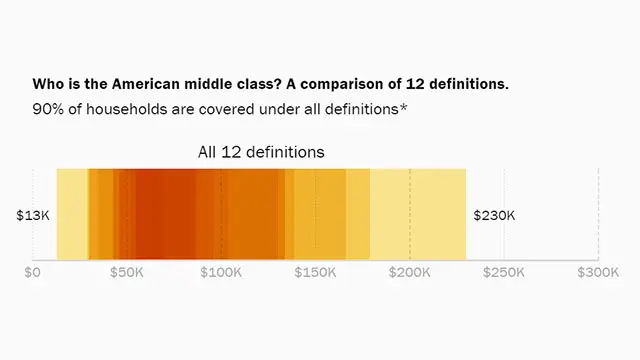Who is the middle class? People with certain jobs or education credentials? Or a certain mindset? People who make a certain amount of money each year?
Does the middle class account for a minority of the population—say, around a third—or does it stretch to include the majority of families? Does it include households with six-figure incomes, perhaps as high as $200,000, or just those with much more modest incomes? Has the middle class seen healthy average income growth in recent years, or has it experienced economic stagnation? Does the middle class receive most of national income, or only a small slice?
The answer to all these questions is: Yes. Depending, that is, on how you define the middle class.
In “Defining the Middle Class: Cash, Credentials, or Culture?” , Richard V. Reeves, Katherine Guyot, and Eleanor Krause examine a variety of ways in which researchers define the middle class, domestically and globally. Even among researchers who define the middle class based on income, the authors show considerable variation in what income bracket reflects middle class incomes. The paper looks at twelve different ways researchers use income to define the middle class.
Comparing experts’ definitions of the American middle class
Share of U.S. households that meet each definition, with annual household incomes ranging from $13,000 to $230,000 a year*
Income share: Share of total U.S. pre-tax, pre-transfer income in 2016.
Income Growth: Growth in average household income since 1980, adjusted for inflation using the PCE deflator.
Share of Households: Share of U.S. households in 2016.
The authors apply the various definitions of middle class to the same income distribution (one drawn from the Current Population Survey and adjusted for household size) and find very different answers to those questions. Taken together, the twelve definitions could mean that nearly nine out of ten U.S. households—with incomes ranging from $13,000 to $230,000—are middle class:
In addition to the wide range of income-based definitions, Reeves, Guyot, and Krause consider those based on wealth, consumption, education, occupation, as well as aspirations or cultural tastes. They emphasize that none of the definitions should be seen as right or wrong. The key point is that, when looking at findings or statistics meant to illustrate the economic status of the middle class, readers should always consider how the middle class was defined. As the inequality experts Anthony Atkinson and Andrea Brandolini have written: “The arbitrariness of any delimitation of the middle class may lead to contradictory results.”
This paper is the second in the Middle Class Memos series from the Future of the Middle Class Initiative at Brookings.
Footnotes
*Data are from the Current Population Survey, Annual Social and Economic Supplement. Income is 2016 total household income before taxes and transfers, adjusted for household size by dividing by the square root of the number of people in the household. We multiply the resulting values by the square root of three to express income in household-of-three equivalents. Note that we have applied each definition to a constant income distribution—the distribution of square-root-adjusted household income—in order to facilitate comparison across definitions. Some authors prefer other methods of adjusting for household size or other measures of income (such as post-tax, post-transfer income), but we have ignored any components of the definitions that alter the underlying distribution of income. Some definitions are derived from more complicated empirical estimations, which we have not replicated here. Additionally, some authors reject the term “middle class” in favor of “middle income” or simply “the middle,” and a few offer multiple definitions of this group (of which we have chosen only one). For these reasons, the definitions represented above should be viewed as based on rather than strictly adherent to the authors’ original definitions.
**We identify the middle class in 1980 by applying each author’s original definition to the 1980 income distribution, adjusted into 2016 dollars. This means that absolute income thresholds (those used by Cashell and Kharas) are the same for the 1980 and 2016 distributions. But for other definitions, we identify the middle class using the 1980 values of median income, percentiles of the income distribution, or the federal poverty level. Since these measures have increased in real (inflation-adjusted) terms over time, income growth can look quite different using a relative definition of the middle class versus absolute thresholds.





